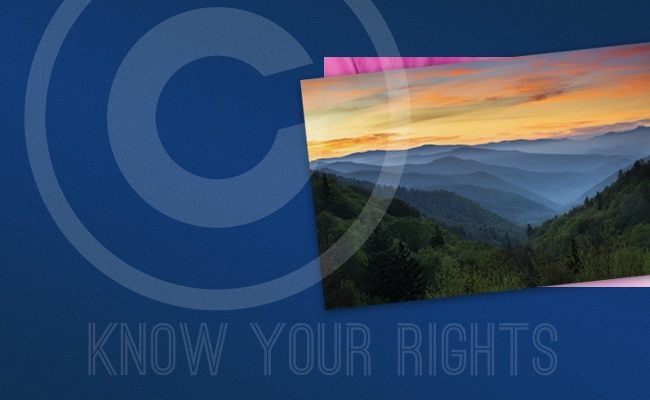Photographers Corner: Contract and Copyright Law
March 8th, 2013
 The following article provides a very personal, but broadly applicable, overview of why and how to protect yourself and your work. Following the steps outlined in this post will provide you and your work with “insurance.” And as the old adage goes, “You don’t know you need insurance until it’s too late.” The article also provides a good summation of the many issues photographers have about their intellectual property rights. Oftentimes this ends up a question of business issues versus creative issues, and the business points are often ranked second when they should be considered first.
The following article provides a very personal, but broadly applicable, overview of why and how to protect yourself and your work. Following the steps outlined in this post will provide you and your work with “insurance.” And as the old adage goes, “You don’t know you need insurance until it’s too late.” The article also provides a good summation of the many issues photographers have about their intellectual property rights. Oftentimes this ends up a question of business issues versus creative issues, and the business points are often ranked second when they should be considered first.
Contracts and Copyright Law – How to Best Protect Yourself by Sid Hoeltzell
The Basics
Photographers often do not realize or remember that we actually own the copyright the moment we create an image. Many photographers believe that this copyright protects our images, when unfortunately it does not. The reality is that copyright is all about the usage agreed to and how we are compensated. If you are a cautious photographer and register all of your copyrighted images with the Library of Congress, this may eventually reward you with a lot of money, save you money, or arbitrate a dispute in your favor. But the key point is to always register and define your usages and transfers of usage rights.
During the 30 years I have spent in the photography industry, I have been involved in several usage rights cases. In my experience I have found that if you are very clear with your licensing agreements in your invoices and your job description, you will not run into problems. Most of the time clients are willing to work with you, but there are reckless ones out there and that’s why it is important to take the necessary precautions.

Covering Your Bases
Creating a clear and distinct set of job descriptions and usages for all your assignment photographs is the most important thing any photographer can do. Regarding all your other work… register it with the Library of Congress. Statistically, it is said that about 90% of all photographers do not register their images with the Library of Congress. Fortunately, it’s not a scary process. Registration is simple and there’s even online help available.
The benefit of registration is that it will potentially help you somewhere down the line, perhaps during an infringement proceeding. This has been instrumental for me a few times over the years. The last time I needed to verify my copyright was in Federal Copyright Court against a French software company. I had registered images with the copyright office and after three years I won a very large federal copyright infringement case against that software company. The result was satisfying. They lost big and paid me a large sum of money. It took three years of my time but I was protected and in the end, that is what mattered.
Negotiating Usage Rights
As I mentioned above, the most important thing that photographers can do is create very specific job descriptions. Be sure to list different angles, or potential angles, and different options for photographing the work. In short, list as much as you can to cover any potential usages that may occur.
In the next part of your invoice list the client’s usage rights. This means listing all of the specifics of how the images can be utilized. You need to be extremely clear here, as you are specifying the rights granted to your client and protecting yourself at the same time.
My standard process is to do a photo fee and then include a one-year usage as described. Then I do a separate section where I include additional usages to give the client options for a greater value. Instead of granting unlimited usage, I recommend that you offer your clients breakdowns according to the media they will actually be using.
For example, website usage may be for an additional two years with a 50 percent fee increase, whereas a national print ad would be for an additional two years at a 100 percent fee. The specifics are up to you but the point is to get the client to think about what they need and make sure they are actually paying for it.
Make sure that you negotiate and release the values that they’re requesting for a specific time. It is important to realize that 100% unlimited usage in all media areas is way too expensive. Also, when they start changing the job in the middle of the session, stop right away and pull out the signed estimate from your files. Advise them that if they “bought a flight from NYC to Miami” and they need the flight to stop in Atlanta and West Virginia you have no problem, but they must agree to the extra fares.
The most important part of the process is getting the client to agree and sign off on the estimate. Get everything in writing as calmly as possible. My little trick is to explain that I’m very happy to do the extra work, but it’s not free.
Establishing Your Rights
In the event that you find your work used in an unauthorized manner, the first step is to check if the images are among the ones you have registered. If not, register the images as accurately and as quickly as possible. Make sure to be very accurate about the dates of creation and first publication.
This also brings up another great reason to make sure you have embedded accurate metadata into all of your files. Relevant data includes copyright notices, websites, addresses and copyright warnings. All this is important if the user stripped this information from the files.
The next step is to contact a reputable attorney. If you belong to an association like ASMP or PPA they can often refer you to attorneys who specialize in copyright infringement and understand the photography industry. Let the attorney give you an opinion on where you stand. After that, stay your course and if you firmly have a case, follow through on it. In the conclusion of a federal case, if all the variables line up, those who used your images illegally will have to pay all attorney fees plus the jury award.
In the end it’s about the money, not the principle. But for you to get satisfaction, you should honor the principle.

Sid Hoeltzell is an award winning commercial photographer who has been an industry professional for over 30 years. Focusing primarily on food and still life photography, Sid works with clients like Burger King, Carnival Cruz, Bacardi, Dewars, Corona and more. With his extensive experience and innovative lighting techniques, Sid makes every job he gets a masterpiece.


